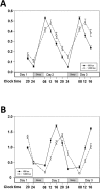Molecular circadian rhythm shift due to bright light exposure before bedtime is related to subthreshold bipolarity
- PMID: 27545669
- PMCID: PMC4992827
- DOI: 10.1038/srep31846
Molecular circadian rhythm shift due to bright light exposure before bedtime is related to subthreshold bipolarity
Abstract
This study examined the link between circadian rhythm changes due to bright light exposure and subthreshold bipolarity. Molecular circadian rhythms, polysomnography, and actigraphy data were studied in 25 young, healthy male subjects, divided into high and low mood disorder questionnaire (MDQ) score groups. During the first 2 days of the study, the subjects were exposed to daily-living light (150 lux) for 4 hours before bedtime. Saliva and buccal cells were collected 5 times a day for 2 consecutive days. During the subsequent 5 days, the subjects were exposed to bright light (1,000 lux), and saliva and buccal cell samples were collected in the same way. Molecular circadian rhythms were analyzed using sine regression. Circadian rhythms of cortisol (F = 16.956, p < 0.001) and relative PER1/ARNTL gene expression (F = 122.1, p < 0.001) showed a delayed acrophase in both groups after bright light exposure. The high MDQ score group showed a significant delay in acrophase compared to the low MDQ score group only in salivary cortisol (F = 8.528, p = 0.008). The high MDQ score group showed hypersensitivity in cortisol rhythm shift after bright light exposure, suggesting characteristic molecular circadian rhythm changes in the high MDQ score group may be related to biological processes downstream from core circadian clock gene expression.
Figures



References
Publication types
MeSH terms
Substances
LinkOut - more resources
Full Text Sources
Other Literature Sources

